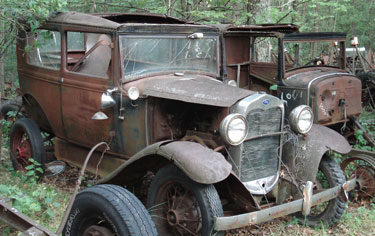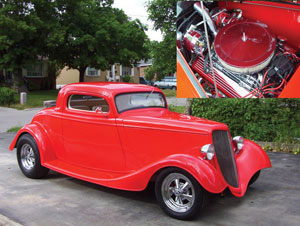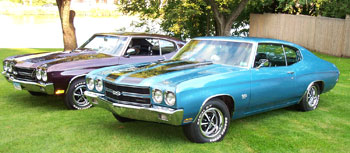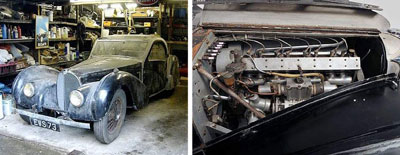Discovering a Rare Find
We’ve all heard the stories and urban legends about old classic cars being found in someone’s garage or estate. Typically, the story goes, the owner just passed away and his widow had no idea what was in the barn. Sounds too good to be true, but it happens. One such story that recently grabbed headlines was that of an old doctor who died at the tender age of 92, leaving behind his beloved but forgotten 1937 Bugatti Type 57S hidden in his garage since he parked it there in the early 1960s.

This car was a rare gem, and in its day it was capable of reaching speeds up to 130 mph when most cars at that time could barely top 50 mph. The car was in unusually good condition for a “barn find,” so it didn’t need many replacement parts, which is a true rarity. The Bugatti ended up selling at an auction in Paris for a cool $4.4 million, which is even more rare.
Cars like the Bugatti are indeed special, but most restoration projects aren’t worth anywhere close to a million dollars. Despite what you may see on Barret-Jackson, there are a lot of restoration enthusiasts who will spend the money to do it right, but who also, especially in these trying economic times, are not going to go crazy with their wallets. Good times or bad, there is still work to be had, and engine builders and enthusiasts who are interested in making old things new again may find that the restoration market is very much to your liking. But, like the vehicles themselves, it takes a rare breed to bring these engines back to life.
Engine builders who specialize in old engines know that it’s a niche market that won’t go away as long as America continues its love affair with the automobile. Baby boomers are getting older and many of them are wanting to buy their childhood cars to drive the wife around at car shows and cruise-ins. There are car clubs for nearly any make and model of car. And many who are involved in these clubs see them as much of a social gathering as a swap meet. It’s a lifestyle.
Restoring Classics
Restored vehicles are older cars which have been brought back to their original condition. A truly restored vehicle is not considered by some experts to be a hot rod, but the lines are blurring more and more. There are new categories of restored vehicles called resto-rods and resto-mods, which are a type of restored hot rod. A
traditional restoration is a vehicle that has been brought back to the way it was when it was brand new.

True restorations, according to experts, have original paint, original interior, and numbers matching engines and chassis. At car shows these “original” vehicles are judged on a 100-point scale. A “100-point car” is one which has 100 percent of its original equipment, down to every nut and every bolt.
Some restoration experts say hot rods, street rods and customs cannot be considered true restored
vehicles because street rodding and customization is about transformation.
Restoration Market
The restoration market has experienced growth over the last few years. According to Egge’s Sam Mandlin, the size of the restoration market was $1.49 billion in 2007, up from $1.33 billion in 2005. The overall size of the hot rod and restoration market is $38 billion (from 2009 SEMA research). These numbers represent those companies whose primary focus is on the production of parts for the restoration of older automobiles.
Resto-Rods/Resto-Mods
Resto-rods are mildly customized older cars. The majority of the vehicle’s features are restored to their original condition, with updated powertrain and suspension. They are sometimes distinguished from fully restored cars by their custom wheels, larger engines or metallic paint jobs. Today “Resto-Mods” are becoming more popular, combining OE-style with the most desirable aftermarket accessories.
“The evolution of the restoration market has been the rat rod, resto-mod, resto-rod car culture,” says Mandlin. “Old school hot rods continue to be popular. Some of the most popular engines are 348/409, 216/235 Chevy, Nailhead Buick, Flathead Ford, Hemi engines, and 331/365/390 Caddys. These engines have a nice look to them and cores are still available at car shows and swap meets.”

Some experts think that resto-mods and resto-rods may become more common than a fully restored vehicles because people like to customize things to their liking. Aftermarket wheels/tires, steering wheels, paint, engine/transmission upgrade, disc brake conversions, interior, etc. all serve to make the vehicle more driver friendly.
Chasing Classic Parts
The parts for a given vintage restoration project may come from different parts of the country; there may be a combination of original and newly produced equipment, which may require a lot of legwork and Internet research to obtain. As a restoration engine specialist, you will have to be prepared to put in extra time that is often required to find, make or repair the correct parts. Your customer is counting on your expertise to get it right.
Some engine parts are becoming more difficult to find, but for many older applications, parts are readily available. Mandlin says new old stock (NOS) is drying up on some applications. He says that Egge will source as many parts as possible in cases where parts are hard to find, but it can make pistons, valves and get gaskets made for a variety of applications along with rebabbitting connecting rods and main bearings.
“Some of our customers call for parts to restore/repair very rare or limited edition foreign automobiles,” says Mandlin. “Depending on the request, Egge may not have the resources to fill the customer’s needs. Egge specializes in domestic vehicles manufactured from the early 1900s to 1980 – our coverage on foreign vehicles is not as extensive. In the past, though, Egge has helped people with components for Rolls-Royce, Talbot Lago, Mercedes, Jaguar and Hispano Suiza. It really depends on the application and what we can do with the customers’ requests.”
Experts say NOS parts are still around and in relatively good supply for many older domestic applications. However, restoration specialists will likely have to rely on a combination of new parts that are custom made for your applications along with the NOS supply.
If you are lucky, you may get to build two engines for one classic car. This is often the case when restoration enthusiasts who own these classics want to drive them and not worry about ruining a numbers matching engine. Muscle car owners in particular are also following this model more and more. Vehicle owners that have the numbers matching components want to restore them and keep them intact as much as possible. But these customers also want to have fun driving the car around and showing off to their neighbors. Who wouldn’t?
Egge’s Mandlin believes there will always be an interest in restored automobiles, “Older vehicles are just more appealing and distinct than newer vehicles. Everyone has a story about his/her first car or a car that their friend had or the car they took their first vacation in. All great reasons to restore a classic car and
recapture the good times and simple pleasures.”
Bugatti Beauty
A 1937 Bugatti Type 57S Atalante Coupe that was discovered in a British garage has sold for about $4.4 million at auction. The car was the star attraction of the Bonhams Retromobile auction in Paris in February. According to Bonhams, only 17 copies of the Type 57S Atalante were built by Bugatti. The car at the auction was originally bought by Earl Howe, the president of the British Racing Drivers Club.

The car passed through a couple of different owners, then was bought by Dr. Harold Carr of Newcastle, England, in 1955.
The car was reportedly parked by Carr in his garage in the early 1960s and not run again until it was discovered in 2007, after Carr’s death.
While the dusty two-seater, unused since 1960, didn’t look like much in the garage in Gosforth, near Newcastle in northern England, auto experts said it was the equivalent of finding an old Picasso or an unknown Beatles tape hidden away in your uncle’s attic.











